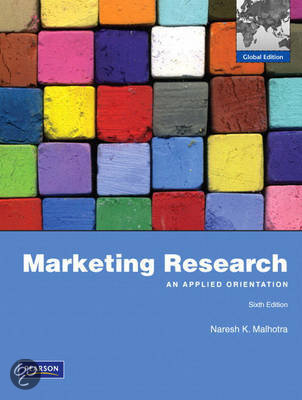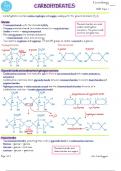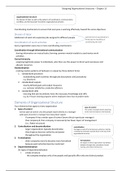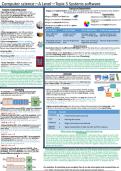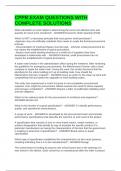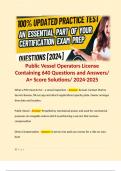,Contents
Textbook Notes
Chapter 1 – Introduction to Marketing Research ............................................................................ 3
Chapter 2 – Defining the Market Research problem & Developing a Research Approach .................. 4
Chapter 3 – Research Design ......................................................................................................... 9
Chapter 10 – Survey & Quantitative Observation Techniques ........................................................ 14
Chapter 12 – Measurement & Scaling .......................................................................................... 18
Chapter 13 – Questionnaire Design.............................................................................................. 22
Chapter 14 – Sampling: Design & Procedures ............................................................................... 24
Chapter 15 – Sampling: Determining Sample Size ......................................................................... 27
Chapter 20 – Frequency Distribution, Cross-Tabulation, & Hypothesis Testing................................ 32
Chapter 21 – Analysis of Variance & Covariance ........................................................................... 38
Chapter 22 – Correlation & Regression......................................................................................... 41
Chapter 24 – Factor Analysis ....................................................................................................... 44
Articles
Predictive Validity of Multiple-Item V/S Single-Item Measures of the Same Constructs ................... 46
Improving our Understanding of Moderation & Mediation in Strategic Management Research....... 47
Reconsidering Baron & Kenny: Myths & Truths About Mediation Analysis ..................................... 53
,Chapter 1 – Introduction to Marketing Research
• The Marketing Research Process
o Step 1: Problem Definition
▪ Identify the problem and define it within the context.
o Step 2: Developing a Research Approach
▪ The development of an approach to the research problem involves identifying
factors that influence research design. A key element of this step involves the
selection, adaptation, and development of an appropriate theoretical
framework to underpin a research design.
▪ Understanding the interrelated characteristics of the nature of target
participants, the issues to be elicited from them and the context in which this
will happen relies upon ‘sound’ theory.
▪ ‘Sound’ theory helps the researcher to decide ‘what should be measured or
understood’ and ‘how best to encapsulate and communicate the
measurements or understandings’.
o Step 3: Research Design
▪ A research design is a framework or blueprint for conducting a marketing
research project. It details the procedures necessary for obtaining the
required information. Its purpose is to establish a study design that will either
test the hypotheses of interest or determine possible answers to set research
questions, and ultimately provide the information needed for decision
making.
▪ Conducting any exploratory techniques, precisely defining variables to be
measured and designing appropriate scales to measure variable can also be
part of the research design.
▪ The issue of how the data should be obtained from the participants (e.g. by
conducting a survey or an experiment).
o Step 4: Fieldwork or Data Collection
▪ Secondary Data:
• The process starts with a more thorough collection and analysis of
secondary data sources. Secondary data are data collected for some
other purpose than the problem at hand. They may be held within
the organisation as databases that detail the nature and frequency of
customer purchases, through to surveys that may have been
completed some time ago that may be accessed through libraries or
through online sources.
• Going through this stage avoids replication of work and gives
guidance in sampling plans and in dividing what to measure or
encapsulate using quantitative or qualitative techniques.
• Secondary data collection and analysis may complete the research
process, i.e., sufficient information may exist to interpret and report
findings to a point whereby the information gaps that the decision
maker has are filled.
▪ Primary Research
• Sampling issues for both quant and qualitative studies. This stage may
include the selection of individuals for in-depth qualitative research.
In qualitative research, the issues of representativeness are less
, important than the quality of individuals targeted for investigation on
the quality of response elicited.
▪ A research problem may require a stage of qualitative and quantitative
research to run concurrently, perhaps measuring and encapsulating different
characteristics of the problem under investigation. Alternatively, a stage of
qualitative research could be used to precede a stage of quantitative
research.
o Step 5: Data Analysis
▪ Data preparation includes the editing, coding, transcription, and verification
of data. This is perhaps the least glamorous aspect of market research but is
critical in ensuring the integrity and accuracy of findings.
o Step 6: Communicating Findings to Stakeholders
▪ The traditional route through which to carry out research would be to
document the research with a written report that addresses the specific
research questions identified, describes the approach, research design, data
collection, and data analysis procedures adopted, and presents the results
and major findings. However, due to increasing pressures on manage rs’ time,
researcher realise that they need to go beyond reports – that may never be
read – and use alternative means. Frequently these are visual, and can include
videos, images, or infographics to enhance clarity and impact.
Chapter 2 – Defining the Market Research problem & Developing a
Research Approach
• By formally developing and exchanging a marketing research brief and research proposal, the
marketing decision maker and the researcher utilise their distinctive skills. They ensure that
the marketing problem and research problems have been correctly defined, and an
appropriate research approach is developed. The research brief and the research proposal are
the formal documents that ensure each party is clear about the nature and scope of the
research task. These documents allow decision makers and researchers formally to present
their perspective of the task in hand.
• Steps of the marketing research process and elements:
o Executive Summary: the proposal should begin with a summary of the major points
from each of the other sections, presenting an overview of the entire proposal.
o Background: The researcher would be expected to have researched and developed
ideas beyond those presented in the brief ‘background’. Other potential causes of the
problems faced, or alternative interpretations of the factors that shape the
background in an environmental context, should be presented.
o Problem Definition: if the researcher sees potential to add value for the marketer
through alternative diagnoses of the problem presented in the brief, then these
should be shown. If the researcher sees a problem in the brief that is ambiguous or
unattainable, other alternative diagnoses should be presented. From this section, the
marketer’s gaps in knowledge should be apparent.
o Research Objectives: these may be presented in the form of clear hypotheses that
may be tested. They may also cover broader areas in terms of ‘research questions’
that are to be explored rather than formally measured in a conclusive manner.
o Research Design: the research design to be adopted, classified in broad terms as
exploratory, descriptive, or causal, should be specified. Beyond such a broad
, classification should be details of the individual techniques that will be adopted and
how they will unfold and connect each other. This allows the reader to clearly see the
methods of collecting the desired data, justification for these methods, and a
sampling plan to include details of sample size(s).
o Fieldwork/Data Collection: the proposal should discuss how the data will be collected
and who will collect them. If the fieldwork is to be subcontracted to another supplier,
this should be stated.
o Data Analysis: This should describe the kind of data analysis that will be conducted,
e.g., content analysis, simple cross-tabulations, univariate analysis, or multivariate
analysis. If software packages are to be used in these analyses, they should be
specified, as they will be indicative of the potential analyses that can be conducted.
o Reporting: the proposal should specify the nature of any intermediate reports to be
presented, what will be the form of the final report and whether an oral presentation
of the results will be made.
o Cost & Timetable: the cost of the research project and a time schedule, broken down
by phases, should be presented. A critical-path method chart might be included.
o Research Organisation & Key Researchers Working on the Project: this can help the
marketer to trust the researchers in problem diagnosis, research design, and
implementation and interpretation of the findings.
o Appendices: any statistical or other information of interest to only a few people should
be contained in appendices.
o Agreement: all parties concerned with fulfilling the research plan should sign and date
their agreement to the proposal.
, • Environmental context of the problem: the tasks involve in understanding the env ironmental
context of the marketing and research problems can include discussions with decision makers,
qualitative interviews with industry experts, and secondary data collection & analysis. The
purpose of these tasks is to develop an understanding of forces that may affect the nature of
decision makers ’problems and related research problems.
• Discussion with Decision makers: it goes beyond the formal presentation of a research brief
and a research proposal are usually vital. The decision maker needs to understand the
capabilities and limitations of the research.
o A problem audit provides a useful framework to develop ideas from a brief, allowing
the researcher to interact with the decision maker and identify the underlying causes
of the problem. It is a comprehensive examination of a marketing problem with the
purpose of understanding its origin and nature. To be fruitful, the interaction must
possess the following characteristics:
▪ Communication
▪ Cooperation
▪ Confidence
▪ Candour
▪ Closeness
▪ Continuity
▪ Creativity
• Interviews with industry experts: in addition to discussion with decision makers, qualitative
interviews with industry experts who are individuals knowledgeable about the firm and the
industry can help in diagnosing the nature of the marketing and research problem. Utilise
unstructured interviews to obtain expert information. Two difficulties when seeking advice
from experts:
o Some individuals who claim to be knowledgeable and are eager to participate may
not really possess expertise.
o It may be difficult to locate and obtain help from experts who are outside the
commissioning organisation, i.e. access to these individuals may be problematic.
• Initial Secondary Data Analysis: secondary data refers to data collected for some purpose
other than the problem at hand. Primary data, on the other hand, are originated by the
researcher for the specific purpose of addressing the research problem.
• Marketing Decision Problem (MDP) & Marketing Research Problem (MRP): the marketing
decision problem asks what the decision maker needs to do, whereas the marketing research
problem asks what information is needed and how it can best be obtained. MDP is action
oriented (Example – How should the loss of market share be arrested? Should the market be
segmented differently? Should a new product be introduced?). MRP is information oriented
(Example – the loss of market share for a product line. How should the decision marker
recover this loss?).

